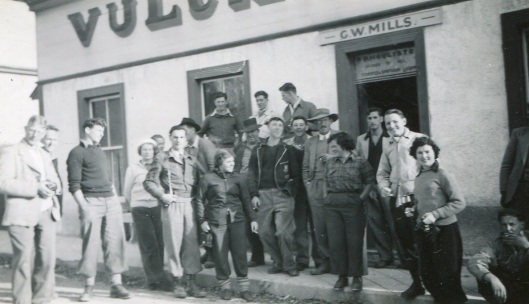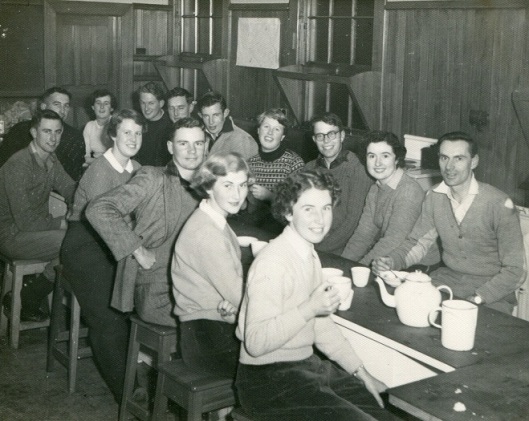Tags

Geography students on a stage III field trip outside the Vulcan Hotel, St Bathans, c.1953. Head of department Ron Lister stands sixth from left in the front. Can you identify anybody else? Photograph courtesy of Patricia Graham.
Geography has the high school syllabus to thank for its beginnings as a university subject at Otago. In recent weeks I’ve posted about a couple of popular subjects that first got their own departments at Otago in the 1960s: psychology and anthropology. Geography got off the ground a little earlier because, unlike those two subjects, it was taught in schools. In 1945 the government introduced extensive changes to the secondary school curriculum, including, among other things, a new focus on social studies. With the school leaving age raised from 14 years to 15 years in 1944, and a policy to reduce class sizes, there was an ever-increasing demand for teachers able to teach junior pupils social studies and senior pupils geography. Secondary principals had already been campaigning for a full university degree in geography for some years, and there was clearly a demand for the subject from people who had enjoyed it at school. World War II only increased this demand – overseas service prompted an interest in geography for some New Zealanders, while others who had stayed home and followed the events of the war also developed a new passion for the subject. Existing geography courses at Auckland and Canterbury could not keep up with the demand.
The department began when Otago’s first geography lecturer, Ben Garnier, arrived late in 1945; from 1946 students could commence a major in geography for a BA, and an MA course began in 1950. Garnier was born in China and educated in England; he completed a master’s degree from Cambridge and taught at Wellington Technical College before taking up the Otago post. After leaving in 1951 he continued his academic career in geography in Nigeria, the US and Canada. Garnier later recalled his first lecture at Otago. The new department was allocated a few rooms in Mellor House, an old home in Union Street (now part of the Department of Psychology), and the furniture arrived just a couple of hours before the first class. “When I entered the lecture room, I could hardly believe my eyes,” wrote Garnier. “Every seat was taken. There were people sitting on the tables and others were propping up the walls, while a substantial number had spilled over onto the verandah outside. Instead of the 20 to 25 students I had been advised to expect, there were, as I remember, between 70 and 80 starting off geography at Otago.” Garnier was delighted at this response, and relieved when the university found them a larger lecture room.
The booming new department got a helping hand from the Professors of Geology and Mines, who lent maps, aerial photographs and equipment to help with the practical elements of the course. The first demonstrator was one of the many returned servicemen flooding onto campus; he was studying mining but his experience as an Air Force navigator made him ideal to teach some geography skills! Richard Greenwood, another Cambridge-trained geographer, arrived early in 1948 as the department’s second lecturer; his wife Eileen, also a geographer, became a demonstrator. Greenwood recalled that the students “were a stimulating mixture of school leavers and returned servicemen.” He taught on the regional geography of Europe and Asia, while Garnier concentrated on physical geography, including his special interest field of climatology. Students interpreted maps and carried out rural and urban surveys as part of their field work. The Taieri was a frequent subject of student surveys, and Karitane was another location mapped and interpreted with varying degrees of success by early students. Senior students went further afield for their practical work. 1940s student Mary Jackson (nee Kibblewhite) recalled a Stage III field trip to Benmore Station, near Omarama, where “my birthday was marked by a day’s deer stalking with four male students and a large meat pie for my birthday cake, which the five of us ate while sheltering from the wind in the snow tussocks high on the hills.”

The 1954 Stage III field trip was based in Balclutha. Ron Lister is on the far right. Seated next to him is Mary Kibblewhite, then possibly Doric Mabon and Elizabeth Blomfield. The woman closest to the camera is Beverley South; next to her is Jocelyn Cole, then John Sinclair and Mary James. At the back left, partially obscured, is Raynor Robb. Second on the right from him is Ray Shave. Photograph courtesy of Patricia Graham.
Regular field trips and tutorials helped create within geography a spirit of camaraderie and the department became well-known for its friendly environment. Though neither Garnier nor Greenwood remained long at Otago, they successfully established, with only minimal resources, a large new department. Their initial work was consolidated by their successors, most notably Ron Lister, who replaced Garnier as senior lecturer in 1952. When geography finally got its first professorial chair, in 1965, Lister was appointed to the role; he retired in 1982 after thirty years as head of department.
Some of the information in this post comes from a wonderful book of reminiscences, From Mellor to Hocken, published in 1995 to mark the department’s 50th anniversary. Do you have any further stories to share of the early years of the Department of Geography? I am grateful to the remarkable Hugh Kidd, long-time geography staff member, for helping identify the photographs. Can you spot anybody else you know in them?

Fascinating article! I was in the Dept 1985-1995. It was such a lovely, sociable dept that I ended up taking rather longer than I should have for my degrees. Also very supportive of students, for which I am very grateful.
Pingback: Off the starting blocks for physical education | University of Otago 1869-2019
Pingback: Our oldest building | University of Otago 1869-2019